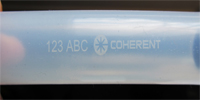20 March 2017
Coherent medical marking case study
 Marking is increasingly important for medical devices and pharmaceuticals to enable product tracking and identification, and also to combat counterfeiting. However, for medical applications, it is essential that the mark itself is not a source of contamination, nor can it contain chemicals that might cause an allergic reaction. Furthermore, it is frequently desirable that the marking process leaves the marked surface smooth, either to avoid tissue irritation/damage or to prevent the mark from becoming a site for bacterial growth.
Marking is increasingly important for medical devices and pharmaceuticals to enable product tracking and identification, and also to combat counterfeiting. However, for medical applications, it is essential that the mark itself is not a source of contamination, nor can it contain chemicals that might cause an allergic reaction. Furthermore, it is frequently desirable that the marking process leaves the marked surface smooth, either to avoid tissue irritation/damage or to prevent the mark from becoming a site for bacterial growth.
The dominant method for marking pharmaceuticals, medical devices, and their associated packaging has long been ink printing, (inkjet or pad printing), while pills are usually imprinted using an offset rotogravure method. The main drawback of printing is that it is often easy to accidentally, or otherwise, remove or alter printed marks (especially if they’re on a paper label). This means that marks can become difficult to read after shipping, handling or storage, and also allows purposeful counterfeiting.
While the inks employed for printing pharmaceutical and medical equipment are non-toxic, the printing equipment itself is often “dirty,” utilising lubricants and solvents that can become airborne and contaminate printed products. Also, printing equipment is often mechanically complex, requiring downtime for cleaning and maintenance.
Now, 355 nm, diode-pumped, solid-state lasers, such as the Coherent MATRIX 355, have emerged as an attractive alternative for both pill and medical device marking. The advantage of this laser is that its ultraviolet output is absorbed strongly by most materials, and it produces a cold, photochemical (rather than photothermal) interaction with any fillers or pigments within the material. The result is a smooth, highly legible mark within the bulk material, rather than at the surface.
Because the mark is actually subsurface, it doesn’t provide a possible home for bacteria, and it is nearly impossible to alter or deface without destroying the material itself. Furthermore, since this is a cold process, there is essentially no heat affected zone (HAZ) or changes to the surrounding material. Also, the short wavelength UV light can be tightly focused, thus supporting complex, high-resolution marks, such as 2D barcodes.
- Contact Information
- Name: Roy Harris
- Email: roy.Harris@coherent.com
- Website: www.coherent.com

